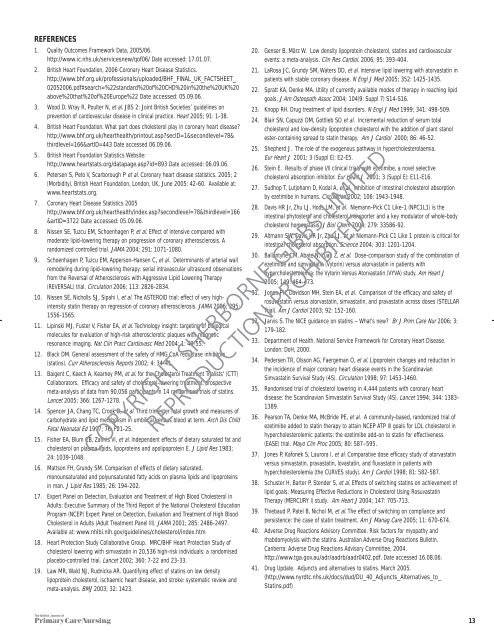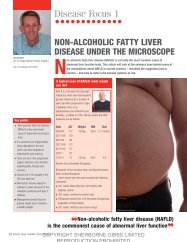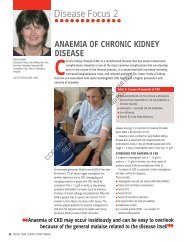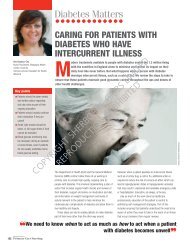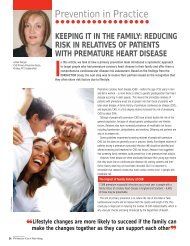Best Practice Principles For cholesterol lowering - The British ...
Best Practice Principles For cholesterol lowering - The British ...
Best Practice Principles For cholesterol lowering - The British ...
- No tags were found...
Create successful ePaper yourself
Turn your PDF publications into a flip-book with our unique Google optimized e-Paper software.
REFERENCES1. Quality Outcomes Framework Data, 2005/06.http://www.ic.nhs.uk/servicesnew/qof06/ Date accessed: 17.01.07.2. <strong>British</strong> Heart Foundation, 2006 Coronary Heart Disease Statistics.http://www.bhf.org.uk/professionals/uploaded/BHF_FINAL_UK_FACTSHEET_02052006.pdf#search=%22standard%20of%20CHD%20in%20the%20UK%20above%20that%20of%20Europe%22 Date accessed: 05.09.06.3. Wood D, Wray R, Poulter N, et al. JBS 2: Joint <strong>British</strong> Societies’ guidelines onprevention of cardiovascular disease in clinical practice. Heart 2005; 91: 1-38.4. <strong>British</strong> Heart Foundation. What part does <strong>cholesterol</strong> play in coronary heart disease?http://www.bhf.org.uk/hearthealth/printout.asp?secID=1&secondlevel=78&thirdlevel=166&artID=443 Date accessed 06.09.06.5. <strong>British</strong> Heart Foundation Statistics Website:http://www.heartstats.org/datapage.asp?id=893 Date accessed: 06.09.06.6. Petersen S, Peto V, Scarborough P et al. Coronary heart disease statistics. 2005; 2(Morbidity). <strong>British</strong> Heart Foundation, London, UK, June 2005: 42-60. Available at:www.heartstats.org.7. Coronary Heart Disease Statistics 2005http://www.bhf.org.uk/hearthealth/index.asp?secondlevel=78&thirdlevel=166&artID=3722 Date accessed: 05.09.06.8. Nissen SE, Tuzcu EM, Schoenhagen P, et al. Effect of intensive compared withmoderate lipid-<strong>lowering</strong> therapy on progression of coronary atherosclerosis. Arandomized controlled trial. JAMA 2004; 291: 1071-1080.9. Schoenhagen P, Tuzcu EM, Apperson-Hansen C, et al. Determinants of arterial wallremodeling during lipid-<strong>lowering</strong> therapy: serial intravascular ultrasound observationsfrom the Reversal of Atherosclerosis with Aggressive Lipid Lowering <strong>The</strong>rapy(REVERSAL) trial. Circulation 2006; 113: 2826-2834.10. Nissen SE, Nicholls SJ, Sipahi I, et al. <strong>The</strong> ASTEROID trial: effect of very highintensitystatin therapy on regression of coronary atherosclerosis. JAMA 2006; 295:1556-1565.11. Lipinski MJ, Fuster V, Fisher EA, et al. Technology insight: targeting of biologicalmolecules for evaluation of high-risk atherosclerotic plaques with magneticresonance imaging. Nat Clin Pract Cardiovasc Med 2004; 1: 48-55.12. Black DM. General assessment of the safety of HMG CoA reductase inhibitors(statins). Curr Atherosclerosis Reports 2002; 4: 34-41.13. Baigent C, Keech A, Kearney PM, et al. for the Cholesterol Treatment Trialists' (CTT)Collaborators. Efficacy and safety of <strong>cholesterol</strong>-<strong>lowering</strong> treatment: prospectivemeta-analysis of data from 90,056 participants in 14 randomised trials of statins.Lancet 2005; 366: 1267-1278.14. Spencer JA, Chang TC, Crook D, et al. Third trimester fetal growth and measures ofcarbohydrate and lipid metabolism in umbilical venous blood at term. Arch Dis ChildFetal Neonatal Ed 1997; 76: F21-25.15. Fisher EA, Blum CB, Zannis VI, et al. Independent effects of dietary saturated fat and<strong>cholesterol</strong> on plasma lipids, lipoproteins and apolipoprotein E. J Lipid Res 1983;24: 1039-1048.16. Mattson FH, Grundy SM. Comparison of effects of dietary saturated,monounsaturated and polyunsaturated fatty acids on plasma lipids and lipoproteinsin man. J Lipid Res 1985; 26: 194-202.17. Expert Panel on Detection, Evaluation and Treatment of High Blood Cholesterol inAdults: Executive Summary of the Third Report of the National Cholesterol EducationProgram (NCEP) Expert Panel on Detection, Evaluation and Treatment of High BloodCholesterol in Adults (Adult Treatment Panel III). JAMA 2001; 285: 2486-2497.Available at: www.nhlbi.nih.gov/guidelines/<strong>cholesterol</strong>/index.htm18. Heart Protection Study Collaborative Group. MRC/BHF Heart Protection Study of<strong>cholesterol</strong> <strong>lowering</strong> with simvastatin in 20,536 high-risk individuals: a randomisedplacebo-controlled trial. Lancet 2002; 360: 7-22 and 23-33.19. Law MR, Wald NJ, Rudnicka AR. Quantifying effect of statins on low densitylipoprotein <strong>cholesterol</strong>, ischaemic heart disease, and stroke: systematic review andmeta-analysis. BMJ 2003; 32: 1423.20. Genser B, März W. Low density lipoprotein <strong>cholesterol</strong>, statins and cardiovascularevents: a meta-analysis. Clin Res Cardiol. 2006; 95: 393-404.21. LaRosa JC, Grundy SM, Waters DD, et al. Intensive lipid <strong>lowering</strong> with atorvastatin inpatients with stable coronary disease. N Engl J Med 2005; 352: 1425-1435.22. Spratt KA, Denke MA. Utility of currently available modes of therapy in reaching lipidgoals. J Am Osteopath Assoc 2004; 104(9: Suppl 7) S14-S16.23. Knopp RH. Drug treatment of lipid disorders. N Engl J Med 1999; 341: 498-509.24. Blair SN, Capuzzi DM, Gottlieb SO et al. Incremental reduction of serum total<strong>cholesterol</strong> and low-density lipoprotein <strong>cholesterol</strong> with the addition of plant stanolester-containing spread to statin therapy. Am J Cardiol 2000; 86: 46-52.25. Shepherd J. <strong>The</strong> role of the exogenous pathway in hyper<strong>cholesterol</strong>aemia.Eur Heart J 2001; 3 (Suppl E): E2-E5.26. Stein E. Results of phase I/II clinical trials with ezetimibe, a novel selective<strong>cholesterol</strong> absorption inhibitor. Eur Heart J 2001; 3 (Suppl E): E11-E16.27. Sudhop T, Lutjohann D, Kodal A, et al. Inhibition of intestinal <strong>cholesterol</strong> absorptionby ezetimibe in humans. Circulation 2002; 106: 1943-1948.28. Davis HR Jr, Zhu LJ, Hoos LM, et al. Niemann-Pick C1 Like-1 (NPC1L1) is theintestinal phytosterol and <strong>cholesterol</strong> transporter and a key modulator of whole-body<strong>cholesterol</strong> homeostasis. J Biol Chem 2004; 279: 33586-92.29. Altmann SW, Davis HR Jr, Zhu LJ, et al. Niemann-Pick C1 Like 1 protein is critical forintestinal <strong>cholesterol</strong> absorption. Science 2004; 303: 1201-1204.30. Ballantyne CM, Abate N, Yuan Z, et al. Dose-comparison study of the combination ofezetimibe and simvastatin (Vytorin) versus atorvastatin in patients withhyper<strong>cholesterol</strong>emia: the Vytorin Versus Atorvastatin (VYVA) study. Am Heart J2005; 149: 464-473.31. Jones PH, Davidson MH, Stein EA, et al. Comparison of the efficacy and safety ofrosuvastatin versus atorvastatin, simvastatin, and pravastatin across doses (STELLARTrial). Am J Cardiol 2003; 92: 152-160.32. Jarvis S. <strong>The</strong> NICE guidance on statins – What’s new? Br J Prim Care Nur 2006; 3:179-182.33. Department of Health. National Service Framework for Coronary Heart Disease.London: DoH, 2000.34. Pedersen TR, Olsson AG, Faergeman O, et al. Lipoprotein changes and reduction inthe incidence of major coronary heart disease events in the ScandinavianSimvastatin Survival Study (4S). Circulation 1998; 97: 1453-1460.35. Randomised trial of <strong>cholesterol</strong> <strong>lowering</strong> in 4,444 patients with coronary heartdisease: the Scandinavian Simvastatin Survival Study (4S). Lancet 1994; 344: 1383-1389.36. Pearson TA, Denke MA, McBride PE, et al. A community-based, randomized trial ofezetimibe added to statin therapy to attain NCEP ATP III goals for LDL <strong>cholesterol</strong> inhyper<strong>cholesterol</strong>emic patients: the ezetimibe add-on to statin for effectiveness(EASE) trial. Mayo Clin Proc 2005; 80: 587–595.37. Jones P, Kafonek S, Laurora I, et al. Comparative dose efficacy study of atorvastatinversus simvastatin, pravastatin, lovastatin, and fluvastatin in patients withhyper<strong>cholesterol</strong>emia (the CURVES study). Am J Cardiol 1998; 81: 582-587.38. Schuster H, Barter P, Stender S, et al. Effects of switching statins on achievement oflipid goals: Measuring Effective Reductions in Cholesterol Using Rosuvastatin<strong>The</strong>rapy (MERCURY I) study. Am Heart J 2004; 147: 705-713.39. Thiebaud P, Patel B, Nichol M, et al. <strong>The</strong> effect of switching on compliance andpersistence: the case of statin treatment. Am J Manag Care 2005; 11: 670-674.40. Adverse Drug Reactions Advisory Committee. Risk factors for myopathy andrhabdomyolysis with the statins. Australian Adverse Drug Reactions Bulletin.Canberra: Adverse Drug Reactions Advisory Committee, 2004.http://www.tga.gov.au/adr/aadrb/aadr0402.pdf. Date accessed 16.08.06.41. Drug Update. Adjuncts and alternatives to statins. March 2005.(http://www.nyrdtc.nhs.uk/docs/dud/DU_40_Adjuncts_Alternatives_to_Statins.pdf)COPYRIGHT SHERBORNE GIBBS LIMITEDREPRODUCTION PROHIBITED13


